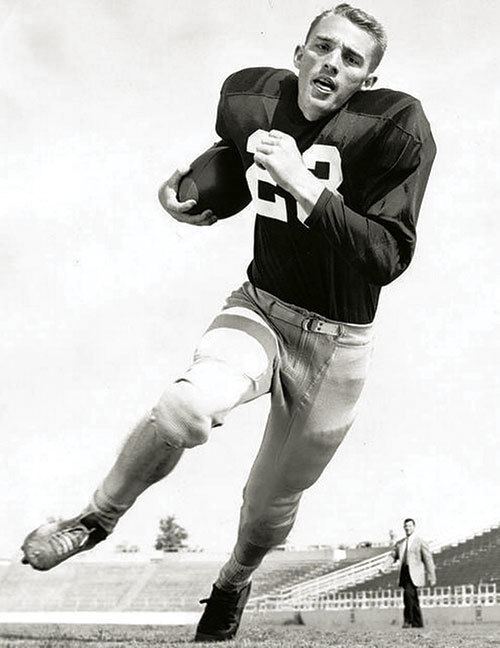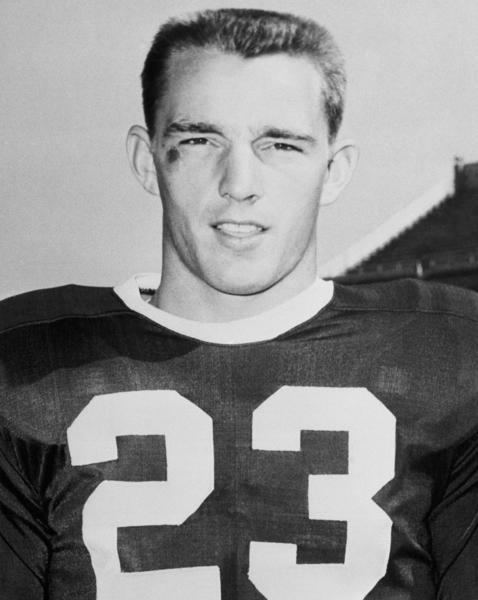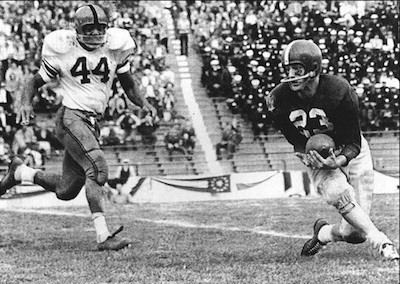Place of birth Sacul, Texas Career end 1960 Place of death Rusk, Texas Position Running back | College Texas Christian Nominations Heisman Trophy Name Jim Swink | |
 | ||
Date of birth (1936-03-14)March 14, 1936 Date of death December 3, 2014(2014-12-03) (aged 78) NFL draft 1957 / Round: 2 / Pick: 25
(by the Chicago Bears) Role American football running back Died December 3, 2014, Rusk, Texas, United States Education Texas Christian University | ||
Dr jim swink honored in rusk
Jim Swink (March 14, 1936 – December 3, 2014) was an All-American halfback at Texas Christian University in Fort Worth, Texas.
Contents

Swink grew up in Rusk, Texas, which led to his nickname, "The Rusk Rambler". He is remembered as one of the all-time greatest running backs in Southwest Conference history, and led the Horned Frogs to consecutive conference championships in 1955 and 1956, which resulted in trips to the Cotton Bowl Classic.

While he was named an All-American as a junior and senior, his best season came as a junior in 1955. That year, he rushed for 1,283 yards, which was second-best in the nation, and led the country with 125 points scored. His best game came against rival Texas in Austin, when he rushed 15 times for 235 yards and scored 26 points in a 47-20 rout of the Longhorns. That year, he finished second to Howard Cassady of Ohio State in the voting for the Heisman Trophy.

After finishing his degree at TCU, he decided to forgo playing in the National Football League and instead went to medical school. In 1960, he joined the American Football League's Dallas Texans for their inaugural season.

According to the book June 17, 1967 Battle of Xom Bi by David Hearne (page 192....)

The presence of thirty-one-year-old Captain James E. Swink, our battalion surgeon, was an additional blessing for our wounded men as they were pulled out of the wood line. During battalion size operations, operations, Swink would often travel with us to the field. He had been assigned to the Black Lions after a five-month stint at the 12th Evacuation Hospital in Cu Chi, Vietnam. He was there in the aftermath of the battle helping the medics with the wounded. Jim Swink was from Rusk, Texas. He had been a famed player in his earlier years earning him the moniker "the Rusk Rambler" as he led TCU to consecutive conference championships and Cotton Bowl appearances. In fact, Captain Swink was a two time “All American” halfback who finished second in the Heisman Trophy voting in 1955. After graduating from TCU, he rejected an NFL career even though drafted by the Chicago Bears. In numerous interviews, Swink stated he had been Inspired by a physician in Rusk, Texas to pursue a medical career.[ 11] It must have been a difficult decision because Swink had proven
himself a formidable football player. He had led the nation in scoring and placed second in rushing in 1955. He got to play against Jim Brown and Swink’s team won. He is also remembered for being the object of the University of Texas expression, “Hook em Horns.”[ 12] Prior to the November 12, 1955, game Texas students had come up with the oft-heard phrase in the hopes of unsettling Swink and his team, the Horned Frogs, but it didn’t work. Even with thousands of Texas students screaming “Hook em horns,” Swink still played one of his best games, rushing for 235 yards on 15 carries for a 15.7-yard average and scored a school-record of 26 points. The Frogs trounced the Longhorns, 47-20 that afternoon. Captain Swink also fought hard for us, and though he had little in the field to work with, just his presence was comforting to us and especially to the medics. With James Swink around there was someone to go to
when a wfor them. Ross Phillips said Swink was accessible and didn’t play the rank game. He said Swink was a fun guy who was always a dedicated doctor. During his tour he was wounded and received a Purple Heart and a Bronze Star metal for his outstanding contribution to the cause.ounded soldier was beyond what a medic felt capable of handling. Captain Swink did whatever he could with the little he had in the field. He said "We can give them some pain medication and start an IV on them or very rarely maybe a system with their airway and breathing.” His biggest goal as he stated, “You get them on a helicopter as fast as you can." In another photograph taken by AP photographer Henri Huet, it shows Captain Swink with his stethoscope dangling from his neck working hard on a wounded soldier. Opposite of him is a soldier with a cigarette hanging from his lips who appears to be assisting. In the background you can see other soldiers, one with his shirt off and two more, probably Jim Callahan and Mike Stout, working on another wounded soldier. The photograph appears to have been taken at a makeshift triage area. The medics liked Captain Swink and he had great respect
for them. Ross Phillips said Swink was accessible and didn’t play the rank game. He said Swink was a fun guy who was always a dedicated doctor. During his tour he was wounded and received a Purple Heart and a Bronze Star metal for his outstanding contribution to the cause.
He later practiced medicine in Fort Worth as an orthopedic surgeon. He was elected to the College Football Hall of Fame in 1980, and in 1982 was presented with a Silver Anniversary Award by the NCAA for career achievements outside of football. In 2005, he was awarded the Doak Walker Legends award.
Swink died December 3, 2014 at his home in Rusk, Texas due to complications of lymphoma. According to his wife he continued his medical practice until he became ill.
